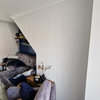Sample Boards or Walls?
Erin Carlyle
7 years ago
Sample boards
Walls
Featured Answer
Sort by:Oldest
Comments (34)
Bev
7 years agoRelated Discussions
Wall boards
Comments (2)We have a very small bathroom and have used wall boards all the way around the room. They are easy to install and keep clean, no grotty grouting!...See MoreAcrylic wall boards/wet walls
Comments (4)I have Nuance panels in my shower from Bushboard. If you look on their website you'll see all the design which fall into 3 price groups. You need BB Complete to use as adhesive and a joint filler which will offer an extended guarantee. There are cheaper panels but you get what you pay for. I too love the idea of no grout. I was sick and tired of cleaning my old tiles. The Nuance looks lovely and is so easy to keep clean....See MoreOSB Board for Garage wall?
Comments (2)Its excellent strength to weight ratio make it ideal for use in construction, furniture, shelves and packaging. That’s why I would choose OSB https://sheetmaterialswholesale.co.uk/...See Morewould silver skirting boards work with purple walls in a bedroom
Comments (5)The silver option is quite unusual - first question - do you own this property ? If yes - great do whatever you like - if no - then probably not. (White skirting with purple might give a similar impression.)...See Moreteamaltese
7 years agoJudy Henry
7 years agoCK Hoffman Design
7 years agoUser
7 years agoUser
7 years agoGigi Lombrano Interiors
7 years agoKristine
7 years agoJane Soroka colour design
7 years agogymguy128
7 years agoSusan Malcolm
7 years agoStudio NOO Design
7 years agopaulie4neil
7 years ago3551urraca
7 years agoUser
7 years agovintagebeachgirl
7 years agoLynn Schultz
7 years agomjkjrobinson
6 years agoLynn Schultz
6 years agoUser
6 years agomjkjrobinson
6 years agoAttaway Homes
6 years agoTri-City Paint & Design
6 years agoUser
6 years agoLunada Consulting & Design, Inc.
6 years agomicxh
6 years agolast modified: 6 years agoUser
6 years agoAmenities Home Design
6 years agoPatricia Carpentieri
6 years agoUser
6 years agoBeverly Cook
6 years agoSarasota FL Real Estate Photographer Rick Ambrose
5 years agolast modified: 5 years agoFaux Like a Pro
2 years ago







Judy Mishkin